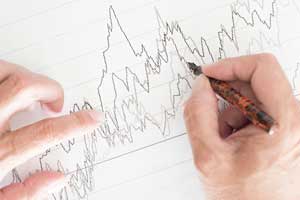St. Louis Fed Index Forecasts Bounce Back in Real GDP Growth

Real GDP rose at a 1.2 percent annual rate in the second quarter, according to the Bureau of Economic Analysis advance estimate. This estimate was well below the 2.6 percent rate predicted by the consensus of professional forecasters and economic analysts.1
By contrast, the St. Louis Fed’s nowcast—termed the Economic News Index (ENI)—was a bit less optimistic than the forecast consensus, predicting 2.2 percent real GDP growth in the second quarter. However, its outlook for the third quarter appears much brighter than the consensus forecast.
About the Economic News Index
Briefly, the St. Louis Fed’s approach creates a simple-to-read index that uses the economic content from key monthly economic data releases to estimate the growth of real GDP during that quarter.2 This index is updated every Friday.
There are several types of nowcasting models, including those produced by the Federal Reserve Banks of Atlanta and New York. Since no single approach seems to dominate all others all of the time, it is probably prudent to look at a variety of models when attempting to assess the performance of the economy in real time.
One unique feature of the St. Louis Fed’s ENI is that it incorporates data that do not directly flow into the calculation of real GDP. A second unique feature is that the economic data are weighted relative to their importance in predicting real GDP growth during the quarter. Since there are several data releases during any one quarter, and a sizable number are revised throughout the quarter (e.g., housing starts and retail sales), the statistical procedure used to estimate the ENI determines whether previous releases should be discounted or weighted more heavily.3
The Current Forecast
Using data through the week ending Aug. 19, the St. Louis Fed’s ENI predicts that real GDP will increase at a 3.5 percent annual rate in the third quarter of 2016. This estimate is about 1 percentage point more than the consensus of professional forecasters surveyed by the Federal Reserve Bank of Philadelphia (2.6 percent), but roughly the same as the 3.6 percent growth predicted by the Atlanta Fed’s GDPNow nowcast.
Still, even if real GDP advances at a 3.5 percent rate in the third quarter, the economy’s four-quarter growth rate will remain rather subdued at around 1.5 percent.
Notes and References
1 See https://research.stlouisfed.org/datatrends/pdfs/usfd/20160729/usfd.pdf.
2 See Kliesen, Kevin; and McCracken, Michael. “Tracking the U.S. Economy with Nowcasts.” The Regional Economist, April 2016, Vol. 24, Issue 2. The ENI will not produce forecasts for the major components of GDP, such as real nonresidential fixed investment.
3 To be clear, most data are released with a one-month lag. Thus, data that measure economic activity in January are typically released in February.
Additional Resources
- Regional Economist: Tracking the U.S. Economy with Nowcasts
- On the Economy: What Is the St. Louis Fed Financial Stress Index?
- U.S. Financial Data
This blog offers commentary, analysis and data from our economists and experts. Views expressed are not necessarily those of the St. Louis Fed or Federal Reserve System.
Email Us
All other blog-related questions



